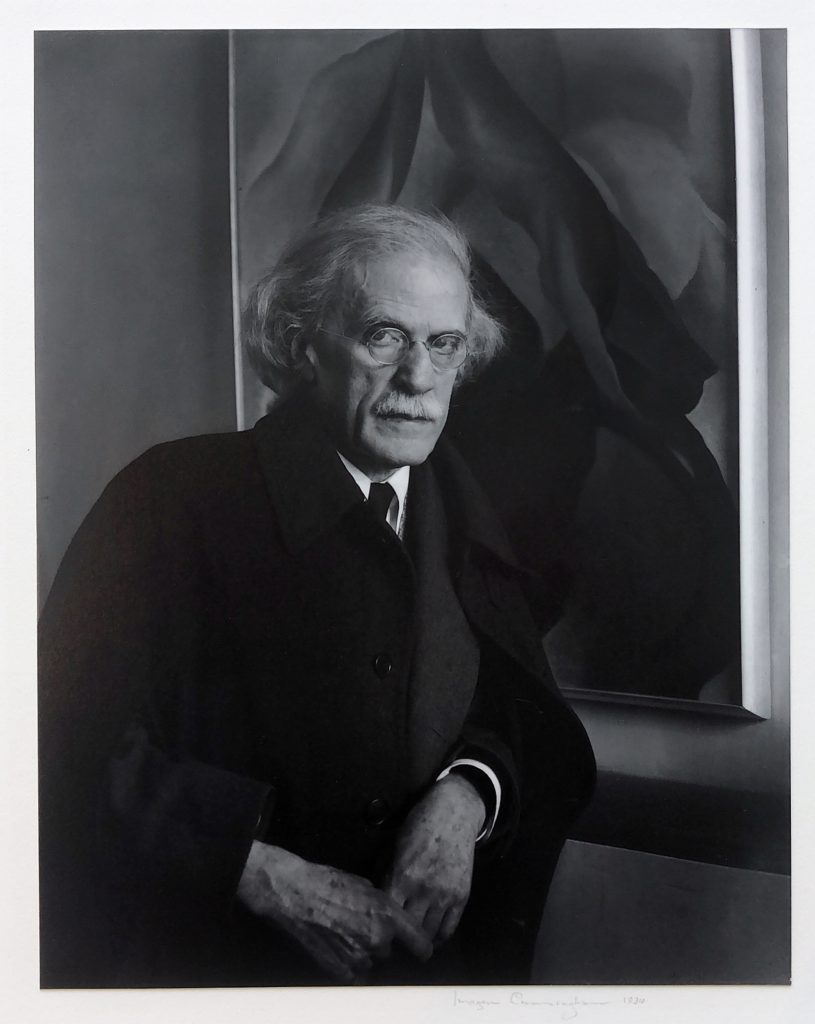Adriana Mullin, 2021

“No photograph taken by a human being can be utterly ‘objective’”1. At first glance, despite appearing to be a simple portrait of artist and collector Alfred Stieglitz, the setting, symbolism, and positioning of the subject matter in this image creates highly subjective content that increases in meaning and appeal as it is viewed and interpreted.
The photo is in black white and composed of Stieglitz in front of a large painting. Stieglitz white shirt and light grey sweater contrast the dark center of the painting in the background, but then are tied together by Stieglitz’s black tie that is in line with the center of the painting creating a dark mid point of the photo. Stieglitz’s light complexion and hair stand out against the darker shades of the painting drawing the viewer into Stieglitz gaze. Cunningham’s photograph is clearly staged as Stieglitz’s gaze is directly aimed at the camera which when viewing the photo makes it appear as though he is making eye contact with the viewer. The direct line of eyesight creates a more intimate experience with both the photograph and Stieglitz. Stieglitz’s line of sight brings into question both his relationship with Cunningham as he would have been staring directly at her, while posing for the shot, as well as Cunningham’s intentions behind how an audience would experience the image. Particularly, because of the proximity in which Cunningham took the photograph creating a narrow frame, minimizing distractions that would take away from the focus of the main subjects of the image, Stieglitz and the painting, adding to the intimate nature of the photo. The intimacy of the shot makes it easier to connect to the work in the search for meaning.
Cunningham positioned Stieglitz in front of a painting, slightly leaning on a ledge in front of it, which hints at the setting of the photo as an art gallery rather than a home or other location. Stieglitz looks relaxed and powerful standing in front of the artwork, posed looking away from it, giving him authority over the work as owner, rather than someone visiting the gallery who would be there to view the art, as it was taken at his gallery “An American Place” in New York.
As the setting is an art gallery, there would have been numerous works of art to choose from for Stieglitz to stand in front of. Cunningham’s positioning in front of this particular painting gives the image symbolic meaning and turns it into a double portrait of Stieglitz and his wife, artist Georgia O’Keeffe, who is represented by her painting.
The knowledge that the painting in the photo is Stieglitz’s wife provides even more meaning that can be derived from the photograph, calling into question their relationship as husband and wife and as an artist and gallery owner. The setting in his art gallery makes it appear as though Stieglitz has ownership over the work as well as O’Keefe, though Cunningham’s positioning of Stieglitz in the photo says otherwise. Stieglitz shares the space in the photo almost equally with O’Keeffe’s artwork, creating balance and a feeling of respect and admiration for the work. This feeling of balance is enhanced by Cunningham’s use of angle as Stieglitz and the painting are both photographed on a diagonal. This brings into question Cunningham’s relationship with the subject of her work. Was she aware of the inner workings of Stieglitz’ and O’Keeffe’s relationship and how did it affect the composition of the photo? The photograph Alfred Stieglitz at An American Place provides more meaning, and demands more questions the more it is viewed.
References
Sylvan Barnet, A Short Guide to Writing about Art, 1989, Pg. 45